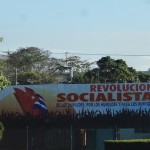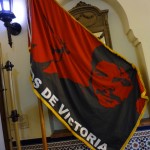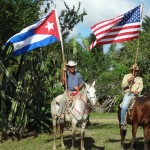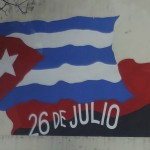 POLITICS: Always remember: “It’s complicated.”
POLITICS: Always remember: “It’s complicated.”
“Revolucion Siempre” Always the revolution. In Cuba, revolution counts, and not just the one in 1959. Signs and slogans are everywhere. Cuba is a country of revolutions: against Spain in 1868 and 1895, and Batista and imperialist intervention in 1959. When I think of Cuba it is one-dimensional: Fidel/Communism/State; for Cubans this is not true. Cubans may not have confidence in Fidel but Cubans never fail to support the revolution.
 “Venceremos” We will win. In spite of Russia, U.S.A., history, or the embargo, they will win. When it comes to the ”embargo pissing match,” Cubans have already won. Face it, they threw the U.S. out and I see no evidence of wanting us back other than as tourists. But last laugh will be on Fidel. The youth’s desire for McDonalds, cell phones and Internet will be his downfall.
“Venceremos” We will win. In spite of Russia, U.S.A., history, or the embargo, they will win. When it comes to the ”embargo pissing match,” Cubans have already won. Face it, they threw the U.S. out and I see no evidence of wanting us back other than as tourists. But last laugh will be on Fidel. The youth’s desire for McDonalds, cell phones and Internet will be his downfall.
“Socialismo o Muerte” Socialism or Death. Someone needed to tell Fidel it was not an either-or situation. It appears Raul understands this and uses China as model to bring Cuban economic policies into the modern century. He must realize that Capitalism is alive and well in Cuba, just not for the ordinary peso-toting Cuban. In fact, I think if Che and the Castros were in the Sierra Maestras today, they would be plotting to overthrow the current regime.
“What are the three successes of the revolution: health, education, sports. Three failures are breakfast, lunch and dinner.” A common joke heard from Cubans.
ARCHITECTURE: Spanish colonial, gothic, neoclassic, and modern styles are everywhere. But decay, lack of plaint and plaster take their toll. Overhead balconies and wrought iron, ornate decorations, wooden windows and doors are a photographer’s delight. Where restoration has occurred, the original architectural beauty of this country shines. Restoration is ongoing in cities like Trinidad and Camagüey that prepare to celebrate their 500th anniversary. Walking their streets, and those in Havana, avoiding the demolition piles and disintegrating plaster trim, one can see the restoration already accomplished and what the future can hold for these beautiful buildings
RELIGION: A poll showed 15% religious, 15% atheist and 70% practice a spiritualism or mysticism. Cubans are superstitious and seem to cover all bases. Religion is tolerated by the State, but there appears to be a lack of enthusiasm for it.
“That which should be possible is forbidden. Everything else is illegal.”
AGRICULTURE: Traveling through the fertile plains of western and central Cuba, I am surprised by vast uncultivated land. It could be planted with grains and vegetables to not only feed the people but to provide fodder for the rather skinny cows, horses and swine. Instead, these lands abound in thorny marabou. And without modern farming equipment, fields are being plowed by oxen and chopped by machete.
CARS: Yes there are classic cars everywhere, right behind the ox carts, bicycles, and horses. Front bumpers wired on, dents pounded out, parts and engines rebuilt – they represent a mechanical miracle. The Cuban mechanic must be the best in the world. But there is no traffic because mostly there are no cars but the classics. The new ability to buy a car will not jam the Malacòn with automobiles, as most Cubans do not have $50-250K to buy one. This will insure that there is no such thing as an abandoned car.
 PEOPLE: When the Cuban cowboys rode into sight carrying the Cuban and U.S. flags, I was optimistic. Cubans were warm, humorous and welcoming. Cubans seem to be one big happy family with the CDR (Committee for the Defense of the Revolution ‘hall-monitor/informer’) just down the block and a wonderful, caring, but paranoid papa.
PEOPLE: When the Cuban cowboys rode into sight carrying the Cuban and U.S. flags, I was optimistic. Cubans were warm, humorous and welcoming. Cubans seem to be one big happy family with the CDR (Committee for the Defense of the Revolution ‘hall-monitor/informer’) just down the block and a wonderful, caring, but paranoid papa.
“For those who leave Cuba thinking it a Paradise, they haven’t seen the people struggling to survive on $25 a month.”
FIDEL: I really think Cubans like him but it is like being disappointed in your dad after you find out he really isn’t who you thought he was. They worry about what will happen when he dies. They will miss him. But I think they will be celebrating like hell when he is gone. But always hoping things will get better.
COWS: The State owns all cows. A Cuban may raise cows for the State (and suffers all costs to do so) but may not eat one. It is okay to sell the milk or make cheese. It is a high crime to slaughter a cow for personal use. However, in order to insure the healthy growth of its children, all beef is rationed by the State to children under the age of seven. Admirable. Except the other exception is for tourist. Therefore, a Cuban will go to jail for eating beef but the tourist will not.
MUSIC: Polyrhythmic Afro, Euro, Caribbean music of drums, guitar and claves (sticks). Music is everywhere, influenced by generations of immigrants who brought their beat, instruments, and sounds with them. Music and dance is unique and the soul of Cuba. Like Spanish bolero colliding with French quadrille and the whole continent of Africa. Artists are treated very well in Cuba and usually make a very good living off their talents.
CUBAN EXILES: In Cuba, seen as a generational conflict between early exiles and old guard leadership of Cuba – they need to die off before improvement. If one leaves he is officially a traitor, a worm. And I heard the resentment towards Florida’s Marco Rubio several times: “He wasn’t born here, never visited, and doesn’t know what he is ranting about!”
“If you disagree with Fidel, you are against Fidel and against the Revolution.”
 ECONOMY: The use of a dual currency (the Cuban peso and the dollar peso) is surreal. Dual currency and the pricing differential it and tourism creates has caused a reemergence of a pre-revolution economic stratification between those with access to dollars and those who struggle to eat on 20 pesos a month. Raul has committed to merging the dual currency by 2015, baited by glimpses of a Free Market economy. One rule remains: you do not compete with the State nor tap into the money line going to the State. Only in 2011 were people allowed to sell property; in 2013 to buy a car (price is problematic so I don’t see a rush to the dealership/State.) The most affected are professionals who are limited in income and leaving. Racial equality becomes questionable, mainly because of the economics.
ECONOMY: The use of a dual currency (the Cuban peso and the dollar peso) is surreal. Dual currency and the pricing differential it and tourism creates has caused a reemergence of a pre-revolution economic stratification between those with access to dollars and those who struggle to eat on 20 pesos a month. Raul has committed to merging the dual currency by 2015, baited by glimpses of a Free Market economy. One rule remains: you do not compete with the State nor tap into the money line going to the State. Only in 2011 were people allowed to sell property; in 2013 to buy a car (price is problematic so I don’t see a rush to the dealership/State.) The most affected are professionals who are limited in income and leaving. Racial equality becomes questionable, mainly because of the economics.
SPECIAL PERIOD: The devastating effect of the pullout of the Soviet Union in 1991 cannot be underestimated. It Cuba could survive that, the U.S. Embargo is like a fly in the bay.
REPARATIONS: Cuba worked out a debt repayment plan with every country but U.S. Under pressure of Miami exiles the 1996 Helms-Burton plan was made into law – no trade until Castro and Communism are gone and debt of $3 billion paid for properties nationalized in 1961. Cuba offered to pay reparations based upon worth of property as claimed on taxes filed so agreement on amount never reached. (No, owners wouldn’t underestimate value to avoid Cuban taxes? Also, much of Havana’s high-rise properties were built and owned by the Mafia.)
EMBARGO: Or, as Cubans want to call it: Blockade. We not only restrict trade but also want everyone else to follow suit. What do Sprite, Pringles, Gerber, Green Giant, Kit-Kat, and Marlboro Lights have in common? All are manufactured by U.S. then shipped to Cuba via a third country. In 1995, Cuba’s economic base shifted to tourism, which earns about $1 billion of GNP. Add the 10% of Cubans receiving remittances of over $800K each year. Embargo? Pointless. Vagaries of politics: since 2001 Cuba has purchased millions of dollars of agricultural products. In fact, the U.S. is its eighth largest trading partner. Imports of produce, medicines, Miami “pack-animals,” and remittances amount to 1/5th of Cuba’s income. It appears a fine line between real and ridiculous.
ODDITIES: Many mentioned how they hated growing up watching Russian cartoons. Now people are addicted to Brazilian soap operas. Cellphones and ATMs (just not ones we can use) were common. Internet was poor but available to University of Havana students. (Go figure, this was the site of Fidel’s revolutionary education, one would think there would be second thoughts about student access.) 110 and 220 electrical sockets exist in hotel rooms.
CUBA HAS IT RIGHT: Free health care and education. Virtually no homeless or unemployment and no guns. Adult literacy is close to 100%. Women have full paid 15-month maternity leave and job waiting when they return. Require women to see doctor and go to hospital for maternity. Abortion is legal. Cubans believe there is global warming. Cuba wants to protect its culture, national identity and socialism and is willing to pay the price to do so. State nationalized valuable, once exclusive property then gave it to others to be used for the health, education and welfare of Cubans. Raul and Obama shook hands. No casino gambling in Cuba. Reassignment of nationalized mansions to arts and museums (U.S. Embassy now a library and natural history museum). After restoration of their building, original residents return paying the same rent as before. Revolution sought land reform, a foreign policy friendly but not monopolized by others, an end to extremes of wealth, and equal pay for all.
CUBA HAS IT WRONG: Land reform broke up the large farms but created a system unable to grow the food to feed its people. Equal pay means most Cubans live equally poor and a few still live very well. No freedom of speech. Cubans now can use hotels, beaches, and restaurants but majority cannot afford it. Forbes Magazine puts Castro’s wealth at over $110 million in 2003 (perhaps he could donate to Havana’s restoration fund). Cuba is adamant about the innocence of the four Miami Cubans imprisoned in 2001 for spying.
 “Speak softly and carry a big stick.”
“Speak softly and carry a big stick.”
I love history, remember Castro coming to power and the Bay of Pigs, and sweated the Cuban missile crisis. But I never knew how wealthy, sophisticated, and developed this “Paris of the Caribbean” was before Castro. Highest standard of living in Latin America, more doctors than England, a party town long before the mafia arrived, a home of Capitalism and capitalist. By 1905 foreigners, mostly Americans owned 60% of Cuban countryside. Corruption was rampant both before and after Batista and the mob. The upper class ran things and always took into account U.S. wishes. Sugar made them wealthy but the U.S. made them strong. Then Che and Castro’s idealism changed it all. Batista and others fled with $$millions.
 Involved in what we call the Spanish-American War, an independent Cuba never was our desire. The U.S. never meant to turn Cuba over to Cubans. As early as Jefferson, we sought to add Cuba to U.S. territory. J. Q. Adams thought it was destined. U.S. history shows support of despots because they allowed our foreign interests to take precedence over their home interests. We tried to buy Cuba, in 1901 forced our right to build a naval base and to intervene in Cuban affairs, Peter Panned their children to the U.S., allow Cuban aliens to all rights once their foot touches our soil, tried dollar diplomacy and when that failed assassination and force. Yet we remain the Cuban’s vision of comfort and success. It is time for common sense diplomacy.
Involved in what we call the Spanish-American War, an independent Cuba never was our desire. The U.S. never meant to turn Cuba over to Cubans. As early as Jefferson, we sought to add Cuba to U.S. territory. J. Q. Adams thought it was destined. U.S. history shows support of despots because they allowed our foreign interests to take precedence over their home interests. We tried to buy Cuba, in 1901 forced our right to build a naval base and to intervene in Cuban affairs, Peter Panned their children to the U.S., allow Cuban aliens to all rights once their foot touches our soil, tried dollar diplomacy and when that failed assassination and force. Yet we remain the Cuban’s vision of comfort and success. It is time for common sense diplomacy.
The embargo/blockade has been petty since the 90s. Also listing Cuba on the Terrorism List – to rank them next to Iran, Sudan and Syria is preposterous. It is now a pissing match to see who can outlast the other. People to People travel is a ridiculous compromise to the Miami Cuban voting block who opposes travel to Cuba (Cubans can and do travel daily to Cuba) and stalls the real issue: dropping all travel restrictions.
Some would argue that travel to Cuba is immoral and only supporting a tyrant (sort of like supporting Chiang Kai-Shek, Trujillo, Pinochet or Noriega). Many of our dollars do end in the hands of the State but the Cubans also earn dollars. Will U.S. tourism change Cuba? Yes, but 3 million tourist already travel to Cuba, especially Canadians and Europeans. According to a one poll, over 67% of Americans favor an immediate end to travel restrictions and 52% want to lift the embargo. Sound common sense, for Americans can benefit as much from the increased trade as can Cubans. Cubans are preparing their infrastructure with restaurants and hotels and awaiting us with optimism. We need to start accepting their hospitality.
Cuba’s biggest change perhaps is in the spoken word. A decade ago, Cubans would have dropped their voice and simply pulled on their nonexistent beards to indicate their leader’s name.
Today “Fidel” is spoken everywhere.
SUGGESTED READING:
Ben Corbett “This is Cuba”
Simon Reid-Henry “Fidel and Che”
Custer and Hernández “History of Havana”
Naomi Klein “The Shock Doctrine: The Rise of Disaster Capitalism”
John Paul Rathbone “Sugar King of Havana”
Martin Cruz Smith “Havana Bay” fiction but a fun read
HINTS:
If possible, pack any paintings you purchase in your suitcase. All rolls are charged duty at the airport. That $20 print you bought will be charged another $4 in duty. Cuban hotels are unique: rooms are the only place I have seen both 110 and 220 outlets, both plainly marked. Food is excellent, beer good, cigars wonderful, restaurants and hotels good.
0 Comments